It’s the biggest scandal in US history. On August 8, 1974, Richard Milhouse Nixon became the first-ever president to resign, mere days before Congress could impeach him. The cause of this epoch-shaking event was the Watergate Scandal, an attempted wiretapping of the Democratic National Election Headquarters and its subsequent coverup. Even now, after four decades of scandals as varied as Iran-Contra, Monica Lewinsky, and whatever the hell was happening in 2016, Watergate remains the gold-standard of high crimes and misdemeanours. “-Gate” has even entered the lexicon as a suffix denoting scandal.
But while most of us are aware of Watergate, how much do we know about the man behind it all?
Born into a blue collar family in 1913, Richard Nixon was a natural political animal. Throughout his House and Senate careers, he earned a reputation as a formidable opponent. First as Eisenhower’s VP, then as President in his own right, he oversaw initiatives that transformed America. Yet the 37th President would wind up dynamiting his own legacy in the most-dramatic way possible. Flawed, paranoid, brilliant; this is the tale of Richard Nixon, the most-controversial president.
The Glory of Poverty
As he would never tire of saying, the 37th President came from a hard background. Born on January 9, 1913, in Yorba Linda, California, Richard Milhouse Nixon grew up not in a fancy-ass mansion, but a modest home he shared with four siblings.
His perpetually-angry father, Frank, owned a service station and a small, failing citrus farm that never brought in much more than a handful of pennies.
As Nixon would later reminisce:
“We were poor, but the glory of it was we didn’t know it.”
However, you could argue this statement was not entirely accurate. For his entire adult life, Nixon would privately rail against those born with a silver spoon in their mouths: the Kennedys, or the wealthy New York Jews he perceived as enemies.
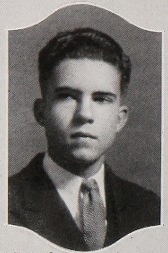
Young Nixon may well have been poor. But he very much seemed to know it. Still, this wasn’t the sort of grinding, soul-sapping poverty that hollows you out. Growing up, Nixon found time to read stacks of books, run for class president, and engage his Quaker mother in energetic debates.
It was in these good-natured arguments that he got his first taste of politics. The dawning of the 1920s brought a string of bad news for the Nixon family. First, the family citrus farm went under, forcing them to leave their home and move to nearby Whittier.
Then, Nixon’s youngest brother Arthur died in 1925, aged only 7.
A few years later, his oldest brother, Harold, also passed away; suffering a long, lingering death from tuberculosis.
It was a traumatic time for the family.
But you wouldn’t know it from looking at Nixon.
At Whittier High School, the boy was excelling, eventually graduating second in his class. He was offered a scholarship to Harvard but, alas, the family was too poor to send him away. Instead, Nixon had to make do with a local Quaker college.
Still, the boy applied himself, earning a reputation as a debate champion; a great football player; and a charismatic actor in the school’s drama productions. When he graduated in 1934, Nixon was so red hot that Duke University’s law school practically threw a scholarship at him.
By 1937, Nixon was a 24-year old qualified lawyer with some of the best grades in the whole damn state. He should’ve been set for life.
But things weren’t so easy for a boy from a hardscrabble background.
Every prestigious law firm Nixon applied to turned him down. Stung, Nixon slunk back to Whittier. He moved in above his parents’ garage, got a deadend job at a small law firm and contemplated how unfair life was.
Here he was, a gifted boy with the grades to match, forced to slum it because… why? Because his parents didn’t have enough money?
But while returning to Whittier would leave a bitter taste Nixon would never shake, it did at least have one positive outcome.
In 1938, Nixon joined a local community theatre.
There, at a rehearsal on January 18, he met Thelma Catherine Ryan. Known to her friends as “Pat”, she was glamorous, beguiling. After driving her home that evening, the young lawyer declared:
“I’d like to have a date with you.”
To which she replied:
“I’m busy.”
Not exactly a fairytale romance.
But Nixon persevered. When he heard Pat enjoyed ice skating – a sport he’d never tried – he spent weeks forcing himself to learn how to skate, just so he could “accidentally” meet her at the rink.
Finally, after a year as just friends, Pat caved. She agreed to that date. On June 21, 1940, Nixon and Pat were married. Together, they agreed to keep chasing their dreams, to keep being ambitious. Two years later, they moved from California to Washington, D.C, where Nixon got a job in the Office of Price Administration.
It was 29-year old’s first foray into the world of politics.
It certainly wouldn’t be his last.
Street Fighting Man
In the end, Nixon lasted less than a year in the Office of Price Administration. An FDR New Deal program, it was the embodiment of big government, something that chilled Nixon to his soul. He quit in disgust.
But rather than return to practicing law, he joined the Navy.
This was a pretty impressive thing to do.
As a Quaker, Nixon was exempt from serving – something of a get out of jail free card considering the massive bloody war going on. But Nixon enlisted regardless, serving in the Pacific.
Although he never saw combat, he still managed to pick up two service stars before resigning his commission in January, 1946. Barely had Nixon swapped his starched, white uniform for a dull gray suit than a group of Republicans from his hometown approached him with an interesting proposition.
Five term Democrat Jerry Voorhis was up for reelection in California’s 12th District. Despite being soft on Communism, no Republican had ever been able to unseat him.
But with a war hero as their candidate, then maybe… just maybe…
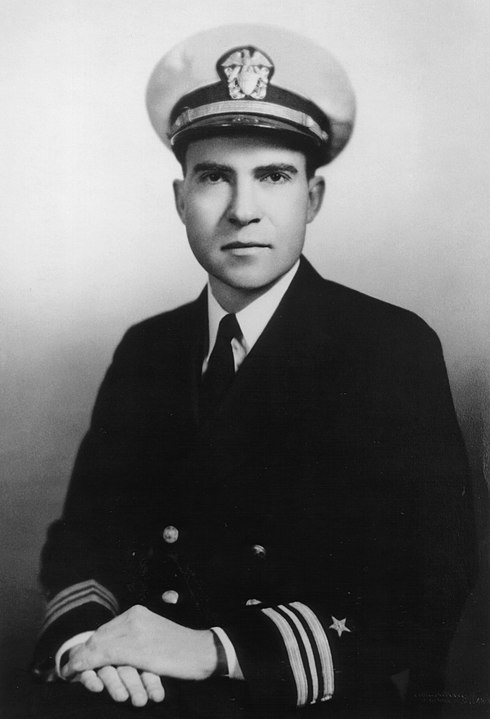
Throughout 1946, Nixon went for the election with the same bloodymindedness he’d shown pursuing Pat. Despite his reputation, Voorhis’s actual connections to Communism were non-existent. So, Nixon just made them up.
At a town hall debate, Nixon flourished a scrap of paper supposedly linking Voorhis to a Communist-linked PAC.
Nevermind that Nixon was actually talking about a completely different PAC. Nevermind that Voorhis was against Communism. In voters’ minds, the Democrat was now a Red. Come November, they voted for Nixon in droves. It was Nixon’s first experience with negative campaigning – the art of not making yourself look good, but making your opponent look worse.
He was an goddamn genius at it.
After a short stint in the House – which included the successful prosecution of Alger Hiss, a State Department employee turned Soviet stooge – Nixon ran for the Senate. This time, his campaigning was so negative it approached absolute zero. Nixon slandered his opponent as “pink right down to her underwear”. His staff handed out “pink sheets,” falsely comparing her voting record to that of Communists.
As in 1946, it worked. Nixon became Senator.
However, he also picked up something else alongside his Senate seat. Aghast at his negative campaign, the California press branded Nixon “Tricky Dick.”
It was a nickname that would stick with him for life.
But what did Dick Nixon care?
From a bright, blue collar kid spurned by elites, he had gone on to become a Washington insider. And his meteoric rise wouldn’t stop there. In 1952, Republican nominee Dwight D. Eisenhower picked Tricky Dick to be his running mate, hoping that Nixon’s California roots would win him the West.
It was Nixon’s ticket to the big leagues.
It was also nearly his undoing.
That September, the New York Post splashed a story of a secret Nixon slush fund using campaign donations to support his lifestyle. Although untrue, it nearly torpedoed Nixon’s chances. Eisenhower called him and basically said:
“Look, Dick. Sort out this massive balls-up or I’ll find a new VP. Got it?”
Nixon got it.
On September 23, 1952, Richard Nixon went on TV to explain himself. It was the first-ever political speech televised live, drawing a staggering 60 million viewers. Before them all, Nixon laid bare his finances in painful, pitiful detail, painting a picture of a struggling, relatable man.
The speech was full of pathetic, human touches, such as when Nixon confessed:
“Pat doesn’t have a mink coat. But she does have a respectable Republican cloth coat, and I always tell her she would look good in anything.”
But what made the speech famous was when Nixon announced he had been given one political gift: a cocker spaniel named Checkers that his children loved.
And, damn it, they were gonna keep that dog.
Known as the Checkers Speech today, the live broadcast saved Nixon’s career. Eisenhower called him up and declared “you’re my boy.”
That November 4, the Eisenhower-Nixon ticket won in a landslide.
It now seemed that Dick Nixon’s rise was unstoppable.
Rise, and Fall… and Rise
There’s an Eisenhower quote that brilliantly sums up Nixon’s time as VP. Asked by a reporter what policies his Veep had contributed, Eisenhower wryly replied:
“If you give me a week, I might think of one.”
But while Nixon wasn’t transforming the nation as VP, he was still working hard on his main project:
To make Richard Nixon look as much like a future president as possible.
That meant doing stuff like going on a tour of Venezuela, where he won praise for cooly dealing with an anti-American mob. It meant stuff like traveling to the USSR, where he engaged Premier Nikita Khrushschev in a spirited debate inside a model American kitchen.
In this quest, Nixon was helped by Eisenhower’s failing health. Starting in 1955, Eisenhower suffered a series of heart attacks that often left Nixon as de-facto president. Despite worries he’d use his temporary role as a bully pulpit, Nixon won plaudits as a sober, sensible leader.
So, when Eisenhower’s second term expired and it became time to pick the next Republican nominee, everyone was squarely behind Nixon.
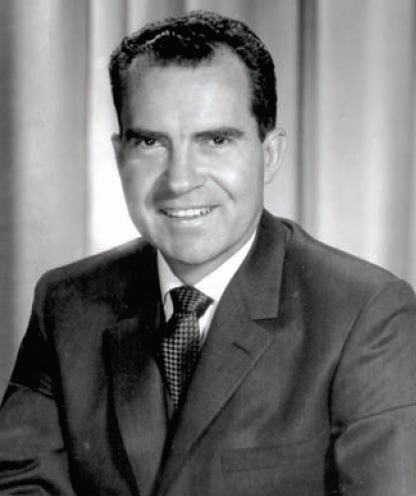
With his experience, Nixon hoped the 1960 election would be a cakewalk, continuing his unstoppable rise. Unfortunately, the blue collar boy was about to go slamming into the glass ceiling. You all know the tale of the 1960 election. How fresh-faced, vibrant John Kennedy completely blew stuffy old Nixon out the water.
But while most people credit JFK’s media nous and wise pick of Lyndon Johnson as his running mate for his victory, Nixon saw it another way.
As the presidency slipped from his grasp, Nixon became convinced that the true culprit wasn’t Kennedy’s charisma, or even the recent recession.
It was Kennedy’s money.
As far as Nixon was concerned, this was just another case of the elites screwing over the working class boy. That November, he felt he didn’t lose the presidency so much as have it stolen from him.
It was the end of Nixon’s rise… and the start of his long fall.
His career in tatters, Nixon returned to California. There, local Republicans convinced him to run for governor. Just two years after failing to become president, Nixon lost California’s gubernatorial race by a depressing margin.
In the wake of the defeat, Nixon called a press conference, where he bitterly declared:
“You won’t have Nixon to kick around anymore, because, gentlemen, this is my last press conference.”
What followed was a period in the political wilderness. Being the political wilderness, it was way more comfortable than the actual wilderness, and saw Nixon become rich for the first time from his law practice.
It also saw the former political streetfighter refashion himself as an elder statesman, making measured observations on the Vietnam War.
However, Nixon was still politically-minded enough to campaign for Barry Goldwater at the 1964 election.
Although Goldwater lost, Nixon’s support made him a darling of the Republican right. It was almost like Nixon was courting conservatives, building himself a powerbase in case he ever decided to run for president again.
It was a shrewd move. As 1968 approached, the Republican party began searching for its next standard-bearer. The obvious choice was an electrifying rising star from California; a former actor christened the future of the party.
That actor’s name was Ronald Reagan, and he’d go on to transform the GOP’s fortunes.
But not in 1968.
As Reagan’s popularity grew, Nixon crept back out the shadows. Began approaching prominent conservatives, ensuring they lined up behind him.
By the time Reagan’s campaign really got underway, the nomination had already been sewn up.
That August, 1968, Nixon was unanimously declared Republican nominee. By now, the Democrats were in chaos. Lyndon B. Johnson had refused to run; the convention had seen riots; and frontrunner Bobby Kennedy had been assassinated.
Against that kinda backdrop, what else could possibly happen?
On November 5, 1968, Richard Nixon swept the electoral college to win the presidency. His popular vote share – 43% – was one of the lowest in history, eaten away by third party candidate George Wallace.
But a win was still a win. Against all the odds, he’d shown them. Shown those stuck up elites, those Kennedys, those New York liberals.
The Nixon era had now begun…
…and Tricky Dick was certain it would go down in history.
Do You Remember… Your President Nixon?
Normally in a presidential Biographics, this would be the point to talk you through their term in office, hopefully with some jokes thrown in. But, since this video is only 26 minutes, and we’ve still got a massive thing called Watergate to discuss, we’re gonna have to just give you the barest overview of the Nixon presidency.
And that’s a shame, because there’s so much to talk about.
Take school busing.
Although education had been desegregated under Eisenhower, geographic separation meant most schools were still mono-colored. One solution was school busing, which involved busing Black children into white schools.
Although Nixon was against the practice, a Supreme Court ruling forced him to enforce it.
Dick’s solution? New Federalism.
At its heart, New Federalism was desegregation – but done by local communities, rather than the government. Biracial committees were established across the South, each charged with implementing desegregation.
Rather than simply passing the buck, it actually worked. Between Nixon’s election and 1970, the number of Black kids in racially-segregated schools dropped from 70 percent to only 18 percent.
Then there’s the environment.
If you’re below a certain age, the words “Republican president” plus “environment” probably conjure images of guys in expensive suits gleefully pouring gallons of oil onto baby seals. But not Nixon. Tricky Dick was well aware that green issues were a vote winner among moderate Democrats, so he leaned into them.
It was on Nixon’s watch that the Environmental Protection Agency was created, and the Clean Air Act passed.
Another thing Dick Nixon supported was women’s rights.
While Nixon’s environmentalism came mostly from cynical vote-grabbing, his desire for gender equality was mostly sincere. Nixon directed the Federal government to launch affirmative action on women’s rights, and passed legislation like Title IX, forbidding sex discrimination in education.
Then there was war.
It was Nixon who started both the War on Cancer, the War on Drugs, plus the actual War in Cambodia after he authorized US incursions. That last one, by the way, led to one of the most infamous non-Watergate moments of his presidency.
On May 4, 1970, peaceful demonstrators gathered at Kent State.
There, before hundreds of witnesses, the Ohio National Guard shot dead four unarmed people, and injured another nine.
Despite massive public outcry, the Nixon White House didn’t prosecute any guardsmen.
The last major Nixon initiative we should talk about is China.
In February, 1972, Nixon surprised the world by going to visit the Middle Kingdom.
“Surprised” because, until that point, China had been America’s boogeyman number 2, right behind the USSR.
But Nixon realized he could keep the USSR in check by cozying up to Beijing. Although the move was cynical, it’s now seen as the moment Communist China started opening up to the world. So there you have it. Four years of Nixon – four of the most dramatic years in modern US history – condensed into about 400 words.
And we still had to leave so much out; from the Oil Crisis, to ending the draft, to the Nixon Shock that ended Bretton-Woods and set the stage for a decade of stagflation.
Still, at least you’re now aware there was more to the Nixon presidency than merely scandal, especially as we move towards the biggest scandal of all.
It’s finally time to talk about Watergate.
Watergate – Part One
The Beastie Boys once sang “I’m-a set it straight, this Watergate,” and that’s exactly what I’m gonna do for you right now. Wish me luck, because it’s super complicated. Although Nixon’s first term was outwardly successful, behind the scenes, Tricky Dick’s paranoia was increasing.
In February of 1971, the 37th President installed a secret taping system in the White House, one activated the moment anyone entered the room.
But the real crazy started on June 13, 1971.
That was the day the New York Times published the Pentagon Papers – top secret documents laying bare American atrocities and incompetence in Vietnam.
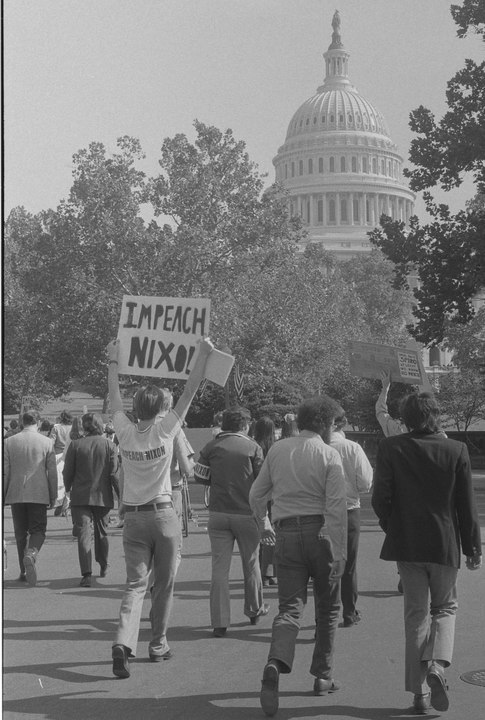
While the papers stopped with Lyndon Johnson’s White House, Nixon was still outraged at the leak. It was from this outrage that the White House Plumbers were formed. A top-secret team, the Plumbers were there to stop leaks through the use of spying, sabotage, and break-ins.
Their first act was to break into the office of the shrink who treated the Pentagon Papers’ leaker.
It wouldn’t be the last time the Plumbers got involved in something shady.
OK, let’s fast forward a year now, to 1972. Nixon is up for reelection, and his most-likely opponent is the formidable Democratic Senator, Edmund Muskie.
That spring, a bizarre string of problems beset Muskie.
White voters in early states were harassed by late night phone calls from rude people who claimed they were Black supporters of Muskie. Others received letters on Muskie stationary that spewed absurd conspiracy theories about his primary opponents.
Yep, it was Nixon, back to his old negative campaigning. But now he had help from both the Plumbers, and the Campaign to Reelect the President – pleasingly abbreviated to CREEP.
And CREEP would stop at nothing to fulfil their mission.
By April, the pressure had torpedoed Muskie’s run, but still the Plumbers were at it. At 2a.m. on June 17, 1972, they broke into Democrat Party HQ in the Watergate Office Building, intending to bug the place.
Instead, they got caught by a security guard.
Within two days, the Washington Post was reporting that one of the burglars was a salaried member of CREEP, but Nixon assumed it would blow over.
He’s actually on tape declaring the story will die, and saying
“Who the hell’s going to keep it alive?”
The two-name answer? Bob Woodward and Carl Bernstein.
All through that hot summer, the Post reporters published articles covering CREEP’s dirty tricks, and linking a Nixon check for $28,000 to one of the Watergate burglars.
But no-one was paying any attention.
Behind the scenes, Nixon was ordering the CIA to interfere with the FBI’s Watergate investigation. Out in the open, the Democrats had nominated leftwing populist George McGovern as their candidate, and Nixon was making mincemeat out of him.
Despite the steady trickle of Watergate stories, Nixon crushed McGovern in ‘72, winning one of the biggest landslides in US history.
Seriously, the only comparable victories are FDR in ‘36 and Reagan in ‘84.
But while the voters had agreed to re-insert Dick into the White House for a second term, the wheels were already coming off the presidency. Just days before Nixon’s inauguration, the seven men involved in the Watergate break-in went on trial.
Perhaps Nixon expected them to stay loyal to him. If so, his trust was misplaced.
Over the next few months, these seven men would nearly all choose saving their own skins over saving Nixon. Tricky Dick couldn’t see it yet, but his presidency was already doomed.
The Fall
Richard Nixon’s second term is a little like reading Shakespearean tragedy reimagined as depressing farce. Barely was Nixon back in the Oval Office than the walls started closing in. On February 7, the Democrat-controlled Senate passed Resolution 60, establishing the Watergate Hearings.
Initially, this didn’t bother Nixon much.
He went on TV to assure viewers he was blameless, that the fault lay with some rouge aides. Most people believed him.
But then May rolled around and things started to unravel.
On the 18th, special prosecutor Archibald Cox was appointed. Shortly thereafter, the secret White House taping system was discovered.
Not unreasonably, Cox was all like:
“Oh, so you’ve been recording your conversations this entire time? Mind if I have a listen?”
To which Nixon was all like:
“Err. No. But I will tell you what’s on the tapes: they definitely, definitely prove I’m innocent!”
As the clamour grew to release the tapes, Nixon’s paranoia reached new heights.
In his head, it was everything he’d ever feared: shadowy elites teaming up with a Jewish reporter to screw over poor, blue collar Dick Nixon.
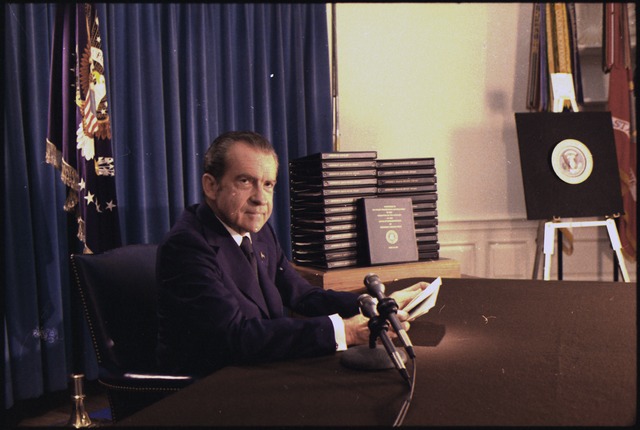
Convinced he had enemies everywhere, the 37th President lashed out in the most self-destructive way possible.
The Saturday Night Massacre on October 20, 1973, was a turning point in the scandal.
In quick succession, Nixon fired both his Attorney General and Deputy Attorney General for refusing to fire Archibald Cox, before his Solicitor General agreed to carry out the order.
Half an hour later, Nixon ordered the FBI to seal off Cox’s offices. It was supposed to kill the investigation through force. Instead, it created outrage.
In the House, impeachment charges were filed. Fellow Republicans began to speak out against their president. Chastised, Nixon was forced to hire a new special prosecutor, Leon Jaworski.
By now, it was clear the president had something to hide.
The rest of the story plays out with painful inevitability.
There’s the infamous “I’m not a crook speech” in November, 1973. The March, 1974 indictment of seven Nixon aides by a Grand Jury.
There’s the subpoena for the White House tapes. The Supreme Court battle that ruled against Nixon on July 24, forcing him to release them.
After that, it was all over.
On August 5, 1974, the first transcripts of the tapes appeared in the media. They included Nixon directing the CIA to interfere with the FBI’s investigation.
The press dubbed this recording “the Smoking Gun”. The strangest thing about Watergate in hindsight is that Nixon really didn’t have anything to do with the break-in.
CREEP and the Plumbers really had gone rouge, and Nixon could’ve probably weathered that smaller scandal.
Instead, he chose to cover it up. And that was a much bigger deal.
Following the release of the transcripts, Congress moved to impeach Nixon. It’s almost certain the votes were there to remove him from office.
But Nixon never gave them the chance.
On August 8, 1974, Richard Nixon announced his resignation – the only president in history to do so. At noon the next day, he and his family left by helicopter. As they departed, Nixon turned, grinned, and flashed a V sign for “victory”.
And so ended Dick Nixon’s presidency.
Less than a month later, on September 8, new president Gerald Ford issued a blanket pardon for any crimes Richard Nixon may have committed while in office. It was a hugely unpopular move, and one that likely handed the Democrats the White House in 1976, but there was nothing anyone could do.
Dick Nixon was now, and would always be, a free man.
The only question now was what to do with all this unexpected freedom.
The End of All That
That’s not a huge amount to say about Nixon’s life after the White House. He and Pat moved back to California, settled in San Clemente. At first, the disgraced president kept his head low, but legal fights had so sapped his bank account that he returned to public life just to get his money back.
And so we got the unedifying spectacle of the Frost-Nixon interviews, which earned Nixon $600,000; and the publication of his memoirs, which netted him $2m. Yet even though Nixon remained a hugely divisive figure with the public, those on Capitol Hill could never quite let go of him.
Across the next fifteen years, Presidents Jimmy Carter, Ronald Reagan, and George H.W. Bush all came to consult with Tricky Dick, searching out his expertise in foreign policy.
By 1990, the image of Nixon as an elder statesman had so entered the political class that three ex-Presidents came to the opening of his library.
In a weird way, this was everything Nixon had ever dreamed of.
Here he was, a man who had committed high crimes and misdemeanours, yet had not only never faced justice; but was now being publicly honored. Does that sound like a blue collar kid from the sticks… or like a member of the privileged elite?
Richard Nixon finally died on April 22, 1994.
At his funeral, President Bill Clinton gave a stirring eulogy that ended with the words:
“May the day of judging President Nixon on anything less than his entire life and career come to a close.”
The political rehabilitation of Richard Nixon was now so total that Watergate was seemingly forgotten. But the story doesn’t end there.
Today, the Watergate scandal is older than… well, me for starters; plus major stuff like Star Wars, the Iranian Revolution, and entire countries like Angola, Slovakia, or Mozambique.
In short, it’s history. Something that happened in the dim and distant past.
Yet, somehow, we still remember it. In a world where even major political scandals like Iran-Contra or the Pentagon Papers have slipped from the public’s mind, that’s saying something.
For whatever reason, Watergate has become only more-notorious. It’s now the gold standard of scandal.
No matter how hard the political class may have tried, it will always stain Nixon’s name, And yet, there’s no denying there was more to the 37th President than a single scandal.
Richard Nixon a complex, flawed, and brilliant man. He was insecure and bullying; but also a man who understood the pain of being an outsider. An ordinary man who really thought he could change his country for the better.
Too often in history and politics, we like to paint simple narratives. This man is a monster, this man is a saint, blah, blah, blah…
But real life is never so simple, and men like Nixon are never simply caricatures, cartoon villains there to be laughed at. They’re human beings who really hurt, really care… and sometimes even manage to do some good.
Richard Nixon may be long gone now, but the lessons we learned from his presidency should stay with us forever. It’s easy to hate such a man. It takes real guts to try to understand him.
Sources:
In-depth bio from the Miller Center: https://millercenter.org/president/nixon/life-before-the-presidency
Biography’s summary: https://www.biography.com/us-president/richard-nixon
Britannica: https://www.britannica.com/biography/Richard-Nixon
Official biography from Nixon Library: https://www.nixonlibrary.gov/president-nixon
Early life and birthplace: https://www.nps.gov/nr/travel/presidents/nixon_birthplace.html
Romance with Pat Nixon: https://www.politico.com/magazine/story/2014/02/nixon-in-love-103490
The Checkers Speech: https://www.theatlantic.com/politics/archive/2012/09/the-checkers-speech-after-60-years/262172/
Nixon shock: https://history.state.gov/milestones/1969-1976/nixon-shock
Nixon goes to China: https://www.history.com/this-day-in-history/nixon-arrives-in-china-for-talks
Kent State Shootings: https://www.history.com/topics/vietnam-war/kent-state-shooting
Nixon and the environment: https://www.sciencehistory.org/distillations/richard-nixon-and-the-rise-of-american-environmentalism
Watergate explainer: https://www.vox.com/2014/8/7/5970967/what-was-watergate-scandal-nixon
Watergate, in-depth: https://millercenter.org/the-presidency/educational-resources/watergate/watergate-break
1972 Dirty Tricks: https://www.politico.com/magazine/story/2016/02/2016-elections-nastiest-presidential-election-since-1972-213644
Kent State: https://millercenter.org/the-presidency/educational-resources/kill-few
Anti-Semitic remarks: https://www.jewishvirtuallibrary.org/nixon-s-anti-semitic-views
List of landslide elections with Nixon in 1974 pretty near the top: https://www.thoughtco.com/landslide-presidential-elections-by-electoral-votes-3367489
I’m not a crook speech: https://www.youtube.com/watch?v=sh163n1lJ4M
Spiro Agnew: https://www.history.com/this-day-in-history/vice-president-agnew-resigns
Resignation: https://www.history.com/this-day-in-history/nixon-resigns
A super-weird picture of 1930s Nixon looking hot: https://www.reddit.com/r/OldSchoolCool/comments/6xivs7/a_young_richard_nixon_will_steal_your_girlfriend/



